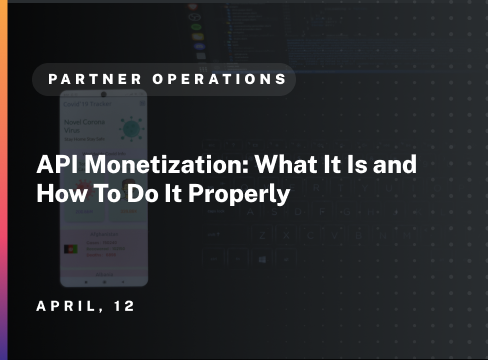API monetization is the process by which companies generate revenue through their APIs. It’s a strategy that involves selling access and carefully designed models that can vary from direct sales to indirect enhancements of service value.
This blog explores different monetization models, the best practices for tracking their success through key performance indicators (KPIs), and how to create mutually beneficial ecosystems.
Whether you’re a startup considering your monetization options or an established company looking to refine your approach, understanding API monetization nuances is crucial for effectively leveraging this powerful business tool.
Monetization Models and Their Impact
Understanding how to monetize APIs is crucial for aligning your strategy with your company’s overall business goals. Each model has benefits and challenges, and choosing which to use can significantly affect your success.
Let’s take a look at three standard models:
1. Revenue Sharing
Revenue sharing involves splitting the income generated from API usage with third parties, typically developers or tech partners. This model encourages collaboration and investment from external developers who can add value to your API.
It’s particularly effective in ecosystems where numerous stakeholders contribute to the platform’s richness and utility. However, setting up a fair revenue-sharing agreement requires clear usage metrics and a transparent relationship with partners.
2. Subscription Fees
Subscription fees are straightforward – users pay a regular fee to access your API.
This model is easy to implement and predict revenue, making it attractive for stable, high-demand APIs. Subscription models can range from flat rates for unlimited API calls to tiered pricing that offers different access levels or performance based on user needs.
The challenge here is pricing your API appropriately to balance attractiveness with profitability.
3. Advertising
Incorporating advertising into your API allows third parties to deliver targeted ads to your API users. This can be particularly effective for APIs that effectively handle substantial user traffic and segment users.
The advertising model often suits free APIs, providing a revenue stream without directly charging users. However, careful implementation is required to ensure that the advertising does not compromise the user experience or the performance of the API itself.
Tracking KPIs for Success
Effective API monetization relies heavily on tracking key performance indicators (KPIs). Identifying and monitoring the right KPIs helps fine-tune your offerings to maximize revenue and improve customer satisfaction.
- Revenue Growth: Track the total revenue generated from the API and monitor growth trends over time.
- User Engagement: Measure how frequently and intensively users interact with your API, which can indicate the value users derive from it.
- Customer Acquisition Costs (CAC): Monitor the cost of acquiring new users for your API, as it can impact the overall profitability of your monetization strategy.
Focusing on these KPIs can help companies gauge the effectiveness of their API monetization and identify areas for improvement. Continuous monitoring and adaptation based on these metrics are vital in sustaining a profitable API strategy.
When Do You Monetize?
Deciding when to monetize an API is as crucial as determining how. Early monetization can discourage initial adoption, whereas delaying too long might miss revenue opportunities. Monetization should begin once your API has established a solid user base and proven its value in the market.
Factors influencing this timing include:
- Market readiness
- The maturity of your API
- User feedback
Monitoring these elements allows companies to strike the right balance, ensuring that the API is robust and valuable enough to warrant monetization without stifling its growth potential.
Creating a Win-Win Ecosystem
Successful monetization boosts revenue and enhances the value your tech partner and developers derive from their association with your API. This approach fosters stronger collaborations and a more vibrant, sustainable API ecosystem.
- Equitable Revenue Sharing: Ensure that revenue-sharing terms are fair and adequately compensate all parties.
- Transparent Communication: Maintain open lines of communication with a tech partner about changes and expectations.
- Support and Resources: Provide your tech partner with the necessary tools and support to succeed in the ecosystem.
- Marketing Opportunities: Offer co-marketing opportunities that benefit your company and your partners.
Companies can build lasting partnerships that enhance their offerings and drive collective growth by adhering to these principles.
Enhancing Customer Retention and Expanding Markets
APIs are powerful tools for enhancing customer retention and opening new market opportunities. By providing more seamless integrations and richer functionality, APIs can significantly improve the user experience, encouraging longer and more fruitful customer relationships.
Integrating an API can allow businesses to expand into new sectors by connecting with other services and reaching new audiences. This diversifies the user base and creates additional value for existing customers, making the business’s offerings more indispensable and integrated into broader workflows.
Moreover, APIs can help fill product gaps and enhance core offerings, which can be crucial for staying competitive in fast-moving industries. Companies that successfully manage their API integrations often see a direct impact on their bottom line, as these enhancements can significantly reduce churn and foster a more substantial, more loyal customer base.
Future of API Monetization
The future of API monetization looks promising, with evolving models and a greater emphasis on ecosystem strategies. As technology advances, so do the opportunities for innovative monetization strategies that cater to a broader range of needs and industries.
Companies are increasingly recognizing the value of APIs as tools and integral parts of their business models.
This shift will likely bring about more sophisticated and nuanced approaches to monetization, including dynamic pricing models and enhanced tech partner programs. Such developments will continue to shape how companies leverage APIs for growth and sustainability in the digital economy.
Conclusion
API monetization is a dynamic and critical aspect of modern business strategies, offering multiple pathways to generate revenue and strengthen partnerships. By choosing the suitable monetization model, tracking key performance indicators diligently, and timing the introduction of monetization strategically, companies can ensure their APIs contribute significantly to their business success. As we move forward, the continued evolution of API monetization will remain pivotal in shaping how businesses innovate and compete in the digital landscape.
Join The 1850+ Leaders Transforming Partnerships
As a member of Partnership Leaders you will:
- Build and learn with the top partner people at the best companies around the world.
- Increase your impact and accelerate your career with proven resources, tools, and best practices.
- Grow a network of peers, partners, and advisors with common objectives.



